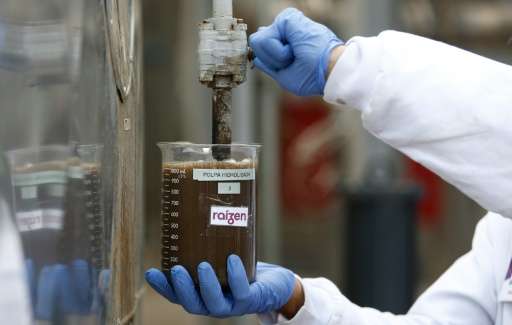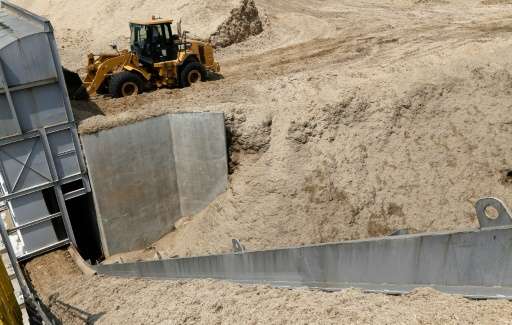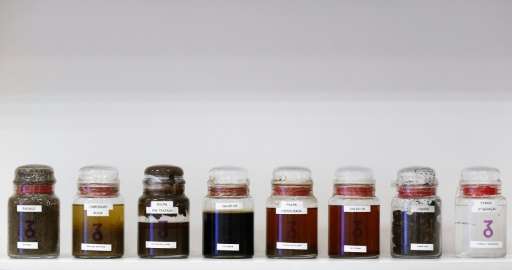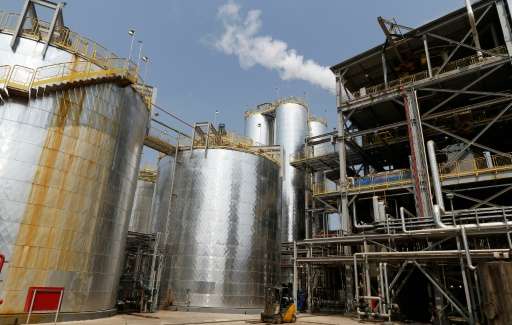Production of cellulosic ethanol, also known as second generation ethanol, in Piracicaba, Sao Paulo
Brazil thinks it has the sweet solution to ridding the world of reliance on fossil fuels for cars and other vehicles: sugar cane ethanol 2.0.
Ethanol—fuel derived from agricultural products—is already well established in Brazil, where more than 60 percent of 36 million vehicles run on ethanol or ethanol-fuel flex systems, rather than straight petrol or diesel.
Brazil, which produces ethanol from sugar cane, is the second biggest producer after the United States, which uses corn as the base.
But sugar cane, requiring vast plantations often hacked out of carbon dioxide-absorbing forests, poses its own problems in the fight against global warming.
Now Brazil is championing what it says could be an answer to that fatal flaw.
Second-generation ethanol, dubbed 2.0 or 2G, can be obtained from the remnants of sugar cane after sugar and standard ethanol production, and therefore requires no new plantations.
"It's a revolutionary product. The big advantage of second generation ethanol is that it boosts the efficiency of the system without needing to expand the cultivated area," said Antonio Stuchi, production director at Raizen, a factory run in a joint venture of Shell and Brazil's Cosan.
Located in Piracicaba, at the center of sugar country about 100 kilometers (roughly 60 miles) from Sao Paulo, Raizen produces sugar, ethanol and 2G ethanol.
However, while there is capacity for 11 million gallons (42 million liters) of the new ethanol, the goal for 2015 is a modest 2.6 million gallons, all to be exported to Europe.
And for now, Raizen and the GranBio factory in the northeast of Brazil are the only sites producing 2G ethanol, making them pioneers in a technology only just getting started elsewhere, including in the United States and Italy.
A digger loads sugarcane bagasse to produce cellulosic ethanol in Piracicaba
Fuel of the future?
The 2014-2015 harvest saw 7.5 billion gallons of traditional ethanol produced in Brazil. President Dilma Rousseff, who visited the Raizen factory in October—her second visit in four months—said she would like to see that rise to 13 billion gallons.
For Rousseff, first and second generation ethanol are a key to Brazil being able to meet its pledge of a 37 percent reduction in carbon emissions before 2025 and a 43 percent cut by 2030.
Eager to boost 2G ethanol, the government financed 87 percent of the $60 million facilities at Raizen.
"This factory qualifies us as a country in international climate change negotiations," Rousseff said in July, referring to the ongoing COP21 climate talks in Paris.
"The fact that we don't need to develop more sources for the 2G, nor to expand the plantations, helps contribute to a significant drop in our gas emissions," Raizen's Stuchi said.
Still, ethanol in general remains dogged by questions, even if 2G removes the need for destruction of forests with new plantations.
The most basic of these is the suitability of using agricultural land to produce fuel for cars rather than food. Others point to the energy consumption required in the production process.
Second-generation ethanol, dubbed 2.0 or 2G, can be obtained from the remnants of sugar cane, and therefore requires no new plantations
Growing pains
Brazil's ethanol industry dates back to the 1970s when the hunt was on for alternative fuels during the oil crisis. Today, low sugar prices and also a steep drop in oil prices have taken some of the momentum out of ethanol expansion.
Experts say that in Brazil, another factor holding back ethanol is the government's heavy subsidy of gasoline to keep fuel prices down.
With the pressure to cut back on polluting fuels growing and the ethanol technology entering a new stage, some believe sugar fuel could come of age. In Brazil, a raising of gasoline taxes and an increase in the ethanol component of flex fuels could support that.
Brazil's ethanol industry dates back to the 1970s when the hunt was on for alternative fuels during the oil crisis
But ethanol still only accounts for five percent of Brazil's energy output. And while second generation ethanol has promise, it is not yet produced on a scale that would allow it to compete commercially with other fuels.
Antonio Bonomi, a researcher at the National Science and Technology Bioethanol Laboratory in Campinas, near Sao Paulo, said more government support for 2G ethanol is needed, since it currently costs 30 percent more than the traditional version to produce.
"It's important to increase bioenergy resources and if this can be done at a competitive price, it will be unbeatable. We have to have an alternative to oil," he said.
© 2015 AFP

























